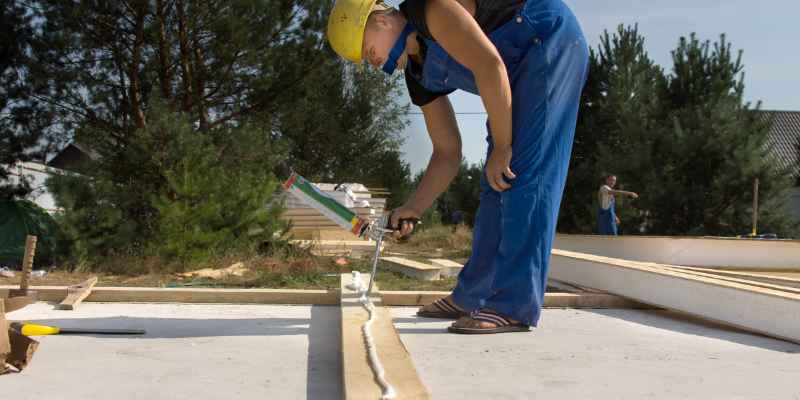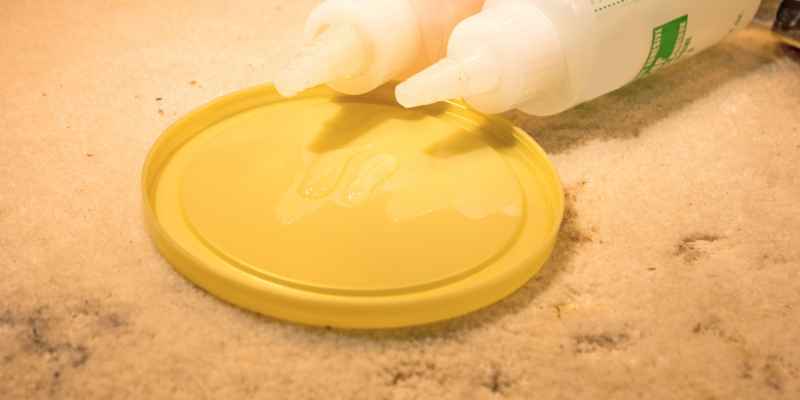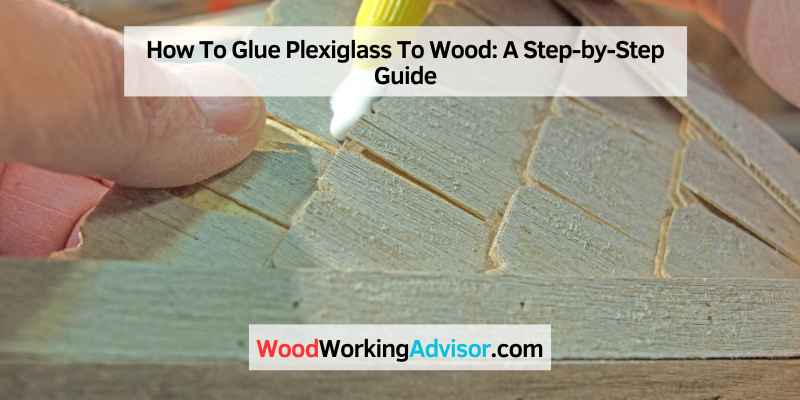To glue plexiglass to wood, you can use an adhesive specifically designed for these materials.
Choosing The Right Adhesive
When it comes to gluing plexiglass to wood, selecting the right adhesive is crucial. The wrong choice could result in a weak bond that easily breaks or deteriorates over time. To ensure a strong and long-lasting connection between these two materials, consider the following factors when choosing your adhesive.
Consider The Materials
Before you dive into the world of adhesives, it’s essential to understand the materials you’re working with. Plexiglass, also known as acrylic, is a lightweight and transparent thermoplastic renowned for its durability and resistance to impact. Wood, on the other hand, can vary in type, such as oak, maple, or pine, each with its unique characteristics.
Due to their different compositions, you’ll need an adhesive that can effectively bond these dissimilar materials together. A bonding agent versatile enough to adhere to both plexiglass and wood is crucial for a successful project.
Research Different Adhesives
Now that you have a clear understanding of the materials involved, it’s time to research different adhesives that are suitable for bonding plexiglass to wood. Here’s a list of adhesives commonly used for this purpose:
| Adhesive | Advantages | Disadvantages |
|---|---|---|
| Epoxy | Strong bond, durable, resistant to moisture and heat | Long curing time, may require mixing before use |
| Cyanoacrylate (Super Glue) | Fast-drying, versatile, bonds quickly | Not suitable for load-bearing applications, brittle |
| Polyurethane | Flexible, waterproof, bonds porous surfaces well | Long curing time, can foam and expand during application |
| Solvent Cement | Creates a chemical bond between materials | Strong odor, can damage some types of plexiglass |
It’s important to examine the advantages and disadvantages of each adhesive to determine which one best suits your specific project requirements. Additionally, consider any special handling or curing instructions provided by the adhesive manufacturer.
Remember that using the right adhesive for your plexiglass and wood combination is crucial to achieve a strong and durable bond. Take the time to research and select the adhesive that best matches your project needs. Armed with the right adhesive, you can confidently tackle your plexiglass-to-wood bonding project and enjoy the results for years to come.

Preparing The Surfaces
To efficiently glue plexiglass to wood, surface preparation is crucial. Ensure both the plexiglass and wood surfaces are clean, smooth, and dry before applying adhesive. Sand the wood and use a degreaser on the plexiglass for optimal bonding.
Clean the plexiglass and wood:
To ensure a strong and durable bond between plexiglass and wood, it is crucial to start with clean surfaces. Begin by wiping down the plexiglass and wood with a mild soap and water solution. This will remove any dirt, dust, or oils that may prevent the adhesive from adhering properly.
Once the surfaces are clean, rinse them thoroughly with clean water and pat dry with a soft, lint-free cloth. It is important to make sure both the plexiglass and wood are completely dry before moving on to the next step.
Sand the surfaces:
Sanding the surfaces of both the plexiglass and wood is another essential step in preparing them for gluing. By sanding, you create a slightly rough texture that allows the adhesive to grip onto the surfaces more effectively.
Start by using a fine-grit sandpaper or sanding block to lightly sand the areas that will be glued together. Be sure to sand evenly and in a consistent direction, as this will help achieve a stronger bond.
After sanding, use a clean, dry cloth or compressed air to remove any sanding residue from the surfaces. This will ensure that the adhesive is applied to a clean and smooth surface.
Remember, proper surface preparation is key to achieving a strong and long-lasting bond between plexiglass and wood. Taking the time to clean and sand the surfaces will greatly increase the success of your gluing project. Now that you have prepared the surfaces, you are ready to move on to the next step of gluing plexiglass to wood.
Applying The Adhesive
To glue Plexiglass to wood, start by cleaning both surfaces thoroughly. Apply an adhesive that is suitable for both materials, ensuring an even and thin layer. Press the two surfaces firmly together and hold in place until the adhesive has set completely.
1. Apply The Adhesive To One Surface
Before starting the gluing process, it’s important to choose the right adhesive for bonding plexiglass and wood. Look for an adhesive specifically designed for this purpose, like a clear epoxy or an acrylic adhesive.
To ensure a strong bond, start by cleaning the surfaces that will be glued. Use a mild solvent to remove any dirt, dust, or grease. Once clean, dry the surfaces thoroughly with a clean cloth or paper towel.
Next, apply a thin coat of adhesive to one of the surfaces – either the plexiglass or the wood. The adhesive should be spread evenly across the surface, using a small brush or a toothpick for precise application.
Remember, less is more when it comes to applying adhesive. A thin coat is enough to create a strong bond between plexiglass and wood, and excess adhesive can lead to messy results.
2. Spread The Adhesive Evenly
Once the adhesive is applied to one surface, gently press the two surfaces together. Start by aligning the edges and then apply even pressure to ensure proper bonding.
Using a clamp or heavy objects can help maintain pressure on the glued area while the adhesive sets. Be careful not to apply too much pressure, as it can cause the plexiglass to crack or the wood to deform. Consult the adhesive instructions to determine the appropriate drying and curing times.
After the adhesive has set, check the bond by gently tapping the glued area. If it feels solid and there are no signs of separation, the adhesive has done its job.
Remember, it’s essential to follow the manufacturer’s instructions for the adhesive you choose, as different adhesives may have specific application requirements.
Joining The Materials
To stick plexiglass onto wood, you need to use a strong adhesive specifically designed for the materials. Make sure to clean and sand the surfaces for better adhesion, and carefully apply the glue using a recommended method. This will ensure a secure and lasting bond between the plexiglass and wood.
When it comes to joining plexiglass and wood, a proper adhesive is crucial for a strong and long-lasting bond. By following these simple steps, you can ensure a secure and seamless connection between the two materials:
Align The Plexiglass And Wood
To begin, it is important to properly align the plexiglass and wood before applying any adhesive. Ensure that the edges of both materials are clean and free from any debris or dust. If needed, sand the edges of the wood to create a smooth surface for better adhesion. Remember, aligning the materials properly is the first step towards achieving a strong bond.
Apply Pressure To Bond
Now that the plexiglass and wood are aligned, it’s time to apply pressure to create a strong bond between the two materials. There are a few methods you can use to achieve this:
- Clamp Method: One effective way is to use clamps to hold the plexiglass and wood together firmly. Place the clamps evenly along the edges of the materials, applying enough pressure to ensure a tight bond. Leave the clamps in place for the recommended curing time of the adhesive.
- Weighted Method: If clamps are not available, you can use weights to apply even pressure. Place heavy objects, such as books or weights, on top of the joined materials. Make sure the weights are distributed evenly across the surface to ensure a secure bond.
- Tape Method: Another option is to use high-quality adhesive tape to hold the plexiglass and wood together. Apply strips of tape along the edges, ensuring it covers the entire joint. The tape will keep the materials in place while the adhesive cures.
Whichever method you choose, it is important to ensure that the pressure applied is even across the entire joint. This will allow the adhesive to bond effectively and create a durable connection between the plexiglass and wood.
By following these steps and using the right adhesive, you can successfully join plexiglass and wood for a variety of projects. Remember to always follow the manufacturer’s instructions when using adhesives and allow sufficient time for the bond to cure. With a little patience and attention to detail, you can achieve a strong and reliable bond that will last for years to come.
Curing And Finishing
Learn the secret to successfully bonding plexiglass to wood. Discover a foolproof method to glue these two materials together for a durable and seamless finish.
Allow Time For The Adhesive To Cure
After successfully bonding the plexiglass to the wood, it’s important to allow sufficient time for the adhesive to cure properly. This curing process ensures a strong and long-lasting bond between the two materials. The exact curing time can vary based on the type of adhesive you used, as different products have different drying times. It is crucial to consult the manufacturer’s instructions to determine the specific curing time for the adhesive you used.
During the curing process, it’s essential to be patient and avoid any unnecessary movement or stress on the bonded surfaces. Any premature handling or manipulation can disrupt the curing process and weaken the bond. Therefore, it’s recommended to let the adhesive cure completely before proceeding with any further steps or handling the glued plexiglass and wood.
Remove Excess Adhesive
After allowing ample time for the adhesive to cure, the next step is to remove any excess adhesive that may have squeezed out during the gluing process. This step is crucial not only for aesthetics but also for ensuring a flush and seamless bond between the plexiglass and wood.
To remove the excess adhesive, start by carefully scraping off any visible globs or blobs using a plastic scraper or a putty knife. Be cautious not to apply excessive force or scratch the surfaces. Once the majority of the excess adhesive has been scraped off, use a clean cloth or sponge dampened with a mild solvent, such as isopropyl alcohol or acetone, to wipe away the remaining residue.
Keep in mind to always follow the manufacturer’s instructions and safety guidelines when working with solvents. Additionally, ensure proper ventilation in your work area to avoid inhaling any fumes.
Removing excess adhesive not only improves the appearance of the final project but also ensures a smoother and more professional finish. It is a crucial step in achieving a clean and seamless bond between the plexiglass and wood.

Frequently Asked Questions Of How To Glue Plexiglass To Wood
What Is The Best Glue For Plexiglass To Wood?
For bonding plexiglass to wood, the best glue to use is a solvent-based adhesive like cyanoacrylate or epoxy. These glues provide strong and durable bonds between the two materials.
What Is The Best Glue For Plastic To Wood?
The best glue for plastic to wood is a strong epoxy adhesive. It forms a durable bond, ensuring the two materials stick together securely.
What Is The Best Glue For Plastic Sheeting To Wood?
The best glue for adhering plastic sheeting to wood is a polyurethane-based adhesive. It provides a strong and durable bond, ensuring the plastic stays firmly attached to the wood surface.
Will Gorilla Wood Glue Work On Acrylic?
No, Gorilla wood glue does not work on acrylic.
Conclusion
Gluing plexiglass to wood can be accomplished with the right techniques and adhesive. By using a suitable adhesive such as epoxy or liquid nails, ensuring a clean and well-prepared surface, and applying even pressure during the bonding process, you can achieve a strong and secure bond between plexiglass and wood.
Remember to follow the instructions provided by the adhesive manufacturer and allow sufficient time for curing. With these tips, you can confidently undertake projects that involve bonding plexiglass to wood.


